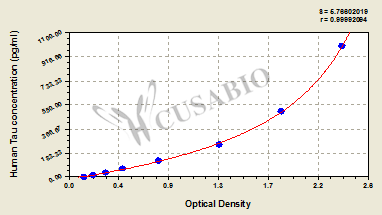The human Tau ELISA Kit is engineered for accurate measurement of human Tau levels from samples including serum, plasma, or cerebrospinal fluid (CSF). It uses the Sandwich-ELISA mechanism in combination with the enzyme-substrate chromogenic reaction to measure the Tau content in the sample. The color intensity is positively correlated with Tau content in the sample. The Tau concentration can be calculated according to the standard curve. This kit is tested with high sensitivity, strong specificity, good linearity, high precision and recovery, as well as lot-to-lot consistency.
Tau, also called MAPT, is the main component of neurofibrillary tangles (NFTs). As a stabilizing microtubule-associated protein (MAP), Tau primarily functions to protect microtubules (MTs) against depolymerization by decreasing the dissociation of tubulin at both MT ends, leading to an elevated growth rate and declined catastrophe frequency. In addition to being a stabilizer of microtubules, Tau is involved in multiple biological processes, including myelination, glucose metabolism, axonal transport, microtubule dynamics, iron homeostasis, neurogenesis, motor function, learning & memory, neuronal excitability, and DNA protection.






